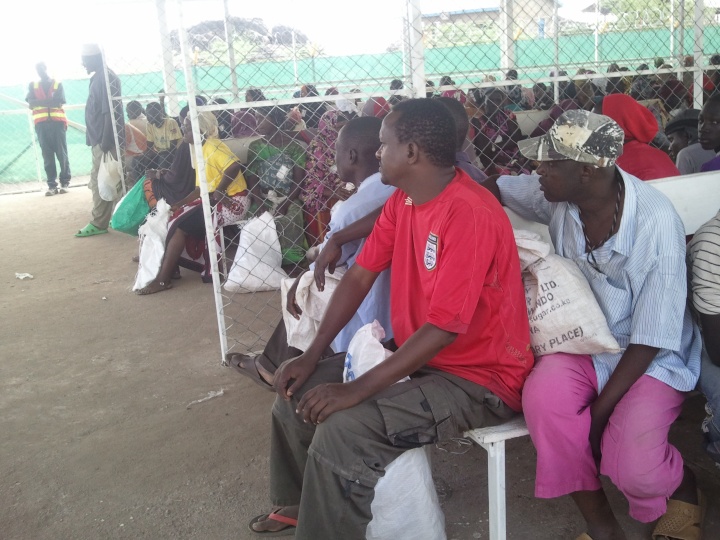The refugees in Kakuma Camp must go through a bio-metric assessment at all the Food Distribution Centers
Since the start of June, 2013, the major camp governing authority (UNHCR) started an exercise in partnership with WFP, to use fingerprinting to check the identities of refugees collecting food rations.
The initiative was aimed to improve accountability between the implementing agencies and the donors because abuse of food resources has been frequently reported. In fact there’s been no or weak assessment or monitoring of the food distribution system over several years.
Biometric technology is used by UNHCR to add or deactivate refugees in their database. Refugees’ and asylum seekers’ fingerprints are scanned during the refugee status eligibility process and in issuing immigration and travel permits. However, for the 22 years that Kakuma has existed, refugees have used standard ration cards to collect their food ration. These are the only identification documents used inside the camp, but they do not show any photo or biometric data.
Refugees in Kakuma get food at the Food Distribution Centers (FDCs), provided by the World Food Programme (WFP). Food is distributed at 15 day intervals, i.e. twice a month. Refugees can hardly wait for the fifteenth day because the food normally gets consumed by the thirteenth day.
The UNHCR and WFP have been accustomed to exchange a manifest or list of every active ration card which entitles anyone to receive food. Some refugees have been found with many ration cards that don’t belong to them but they can easily collect a huge amount of food at every food distribution cycle, thus perpetuating a trade in aid between refugees and local people, while food is also transported as far as Kenya’s urban centers.
In the new system of fingerprinting only the card owners are entitled to receive food rations: “No match no food”.

The exercise was officially launched by the UNHCR, WFP and Food Aid donors who would be provided with an account of what number of refugees received food on a particular day during the distribution exercise, as well as determining the quantity of food distributed.
The field assessments and exercise could further be easily made available to donors through the structured online system. Immediately a refugee is fingerprinted at an FDC when collecting food rations, their fingerprints appear at the three major offices for verification purposes.
Refugees have expressed insecurity concerns about the exposure of their identity, between three major categories of Aid Agencies and the Government of Kenya.
In the past, between 2007/8 the same system was tested in the camp but failed because refugees opposed the system due to concerns over security and identity. In 2013, the process has been made mandatory so that refugees are forced to go through the system.
“The refugees felt insecure and harassed to have to present their fingerprints to collect the rations,” a refugee zonal leader told Kanere.
“I don’t like this idea but I was forced, why is UNHCR and other agencies interested in refugees finger printing, I think this business should come to an end and people should be protected,” said Ali Mohamed.
On two separate occasions Kanere reporters approached WFP office in Kakuma for an interview but without success.
In speaking with the UNHCR, KANERE learnt that the motives behind the new system was to allow transparency and manageable data base structure between beneficiaries and all the food implementing partners including the Aid Donors, despite the fact that refugees felt harassed and inferior to have to go through a fingerprint scan to collect the food entitlement.
Another issue is that if a refugee missed to collect his or her food for more than two consecutive food distributions, the individual or family’s ration card is deactivated. This has posed a threat to refugees who wish to work outside the camps for survival. The Kenyan Refugee Act allows refugees to live and work where they feel is favorable but this right is not supported by the refugee protection authority. Refugees are required to remain in the designated camps unless officially authorized to travel outside them.
The refugees who have gone outside the camp for different reasons are forced to come back to already congested, insecure camps. Others stated that they cannot return back to Kakuma because of inadequate food rations. “I lived in Nairobi for nine years. I don’t see meaning as to why UNHCR want to force people back to camps, with no added food, less quality etc,” said Abebe, an Ethiopian from Nairobi.
Since the fingerprinting was started, more than 25,000 ration cards may have been deactivated according WPF Food Advisory Committee members. However according to a UNHCR official, there are only 15,000 ration cards or individuals who will be made inactive from the UNHCR database. “There are 15,000 persons who have not reported to collect food rations, meaning these individuals are not in the camp,” a UNHCR official commented in a statement at FDC 3 in the Camp.
According to some refugee leaders who wish to remain anonymous, there has been a plot to counter attack the new system with poor coordination. “We did not welcome the system, force is used indirectly bring people to this terrible camp, yet food rations are reduced since the procedure begins,” a refugee leader said outside the agency’s compound.
“The entire process is frustrating because the authorities demand every refugee to come back to camp but many people have gone to urban centers due to employment, incentives are not increased,” another refugee leader added.
Despite the fact that Kakuma camp has existed for 22 years, the mode of food distribution through bio-metric assessment is only now being implemented in both Kakuma and Dadaab complex. The move is believed to foster accountability and transparency in food monitoring but why have they started it so late?
How does the authority benefit from forcing people to present their fingerprints to collect the food is a question that lingers in refugees’ minds?
